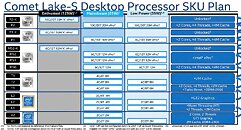Friday, December 27th 2019

Intel Enthusiast-Grade K Processors in the Comet Lake-S Family Rumored to Feature 125 W TDP
This piece of news shouldn't surprise anyone, except for the fact that Intel is apparently signing on a TDP of 125 W for even its K-series unlocked processors for their next-generation Comet Lake-S family. Intel's current Comet Lake 9900K CPU features a TDP of "only" 95 W - when compared to the rumored 125 W of the 10900K), whilst their current top offering, the i9-9900KS, features a 127 W TDP. Remember that Intel's 10900K should feature 10 cores and 20 threads, two extra cores than their current 9900K - this should explain the increased TDP, a mathematical necessity given that Intel can only count on marginal improvements to its 14 nm fabrication process to frequencies and power consumption of its CPUs.
A leaked slide from momomo on Twitter shows, if real, that Intel's future enthusiast-grade CPUs (likely i5-10600K, i7-10700K and i9-10900K) will feature this 125 W TDP, while other launches in that family will make do with the more traditional 65 W TDP (interesting to see that Intel has some 10-core CPUs with 65 W TDP, the same as their current 9900, despite two more cores). A footnote on the leaked slide shows that these K processors can be configured for a 95 W TDP, but this would likely come at a significant cost to operating frequency. Intel seems to be bringing a knife to a gunfight (in terms of core counts and TDP) with AMD's Ryzen 3000 and perhaps Ryzen 4000 CPUs, should those and Intel's future offerings actually coexist in the market.
Sources:
user momomo @ Twitter, via Videocardz
A leaked slide from momomo on Twitter shows, if real, that Intel's future enthusiast-grade CPUs (likely i5-10600K, i7-10700K and i9-10900K) will feature this 125 W TDP, while other launches in that family will make do with the more traditional 65 W TDP (interesting to see that Intel has some 10-core CPUs with 65 W TDP, the same as their current 9900, despite two more cores). A footnote on the leaked slide shows that these K processors can be configured for a 95 W TDP, but this would likely come at a significant cost to operating frequency. Intel seems to be bringing a knife to a gunfight (in terms of core counts and TDP) with AMD's Ryzen 3000 and perhaps Ryzen 4000 CPUs, should those and Intel's future offerings actually coexist in the market.

96 Comments on Intel Enthusiast-Grade K Processors in the Comet Lake-S Family Rumored to Feature 125 W TDP
check out some in game youtube comparisons.
same testing methodology for the two,the 9700k is 10 degrees cooler at least.
like here,9700k 5ghz vs 3700x 4.3ghz,9700k runs cooler by 10 degrees despite higher OC and higher usage
you seem to be bothered by everything intel does and none that amd does.
these cpus are on far ends of spectrum.
9900k is to gaming what 3900x is to rendering.
I strongly believe in picking what cpu suits your usage scenario not going by purely cost per core or synthetic benchmarks.
9900k is cooler in gaming despite having fewer cores,higher tdp and older process.3900x is cooler in rendering because of more cores.all in all,it's the end result that matters.
Intel TDP is power consumption for sustained loads, not base clock. According to Intel's specs the CPU will throttle to the TDP, but allow short bursts above TDP, unless you disable the power limit. E.g. for i9-9900K it allows bursts up to ~28 seconds. Even the 127W i9-9900KS does consume only 127W sustained (at ~4.7 GHz all core) (unless the power limit is removed), with bursts up to ~185W where it achieves 5.0 GHz all core.
AMD's TDP rating for Zen has nothing to do with power at all. Their formula is the following:
TDP = (tCase - tAmbient) / HSF
tCase is usually 60-70°C - the max temperature between the silicon and the IHS before it will throttle.
tAmbient may be 42 or 32°C - maximum temperature at the heatsink inlet.
HSF - minimum required heatsink resistance ("heatsink quality").
All of these may vary from product to product.
AMD will boost their CPU cores individually until they reach a heat or voltage limit, per core individually. So Ryzen 3000 chips can easily use quite a bit more power than their TDP rating, but will work "fine" at a cooler matching their TDP rating, you may just loose some boosting potential.
The big difference here is that Intel will only exceed TDP in bursts but will throttle to TDP, even if you have cooling capacity for 300W. While Zen 2 may will have a sustained power draw that is more unpredictable, and is more dependent on the efficiency of the cooler and the ambient temperature. Zen 2 CPUs may use more power sustained than their TDP rating if the cooling is sufficient. On top of that Zen have the XFR which boosts above this in very tiny bursts.
Regardless of brand, I always recommend having at least 20-30% cooler headroom when building a PC; because of TDP meaning discrepancies, and obviously to get the maximum burst speed, but also to keep the noise at acceptable levels and since temperature affects longevity. Having a decent cooler is especially important for Ryzen 3000 series if you want all the performance you paid for. This doesn't mean you need an overkill water cooler though, just pick a good Noctua cooler and ensure good case airflow(!).
Intel Core i9-10900K 10-core to boost up to 5.3 GHz using "Thermal Velocity Boost".
videocardz.com/newz/intel-core-i9-10900k-to-boost-up-to-5-3-ghz-specifications-of-10th-gen-core-comet-lake-s-leaked
Quicksync - H.264 rendering
CUDA - Effects rendering
For me it's the best of both worlds. Can game uncompromised and can render like no tomorrow. Yes please.
I've had 4 gpus on my current z97 platform,always had to fall back on my igpu in between cards.
mighty useful when troubleshooting my pc too.